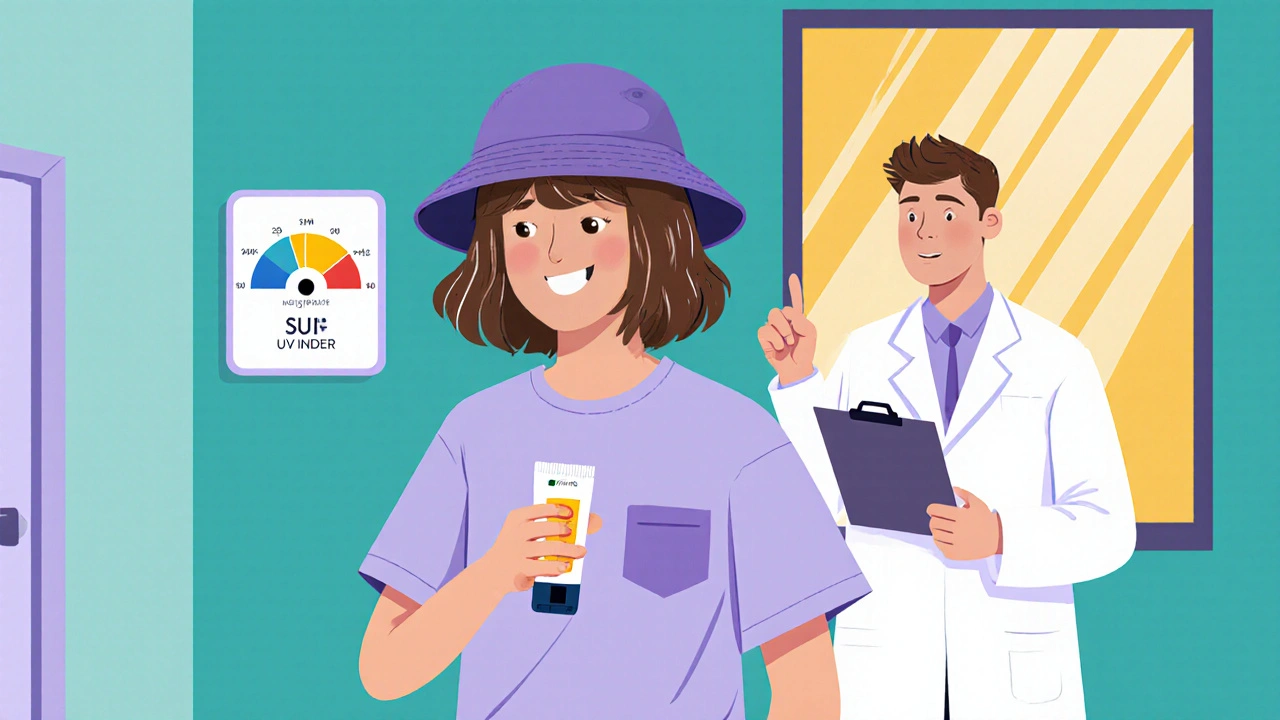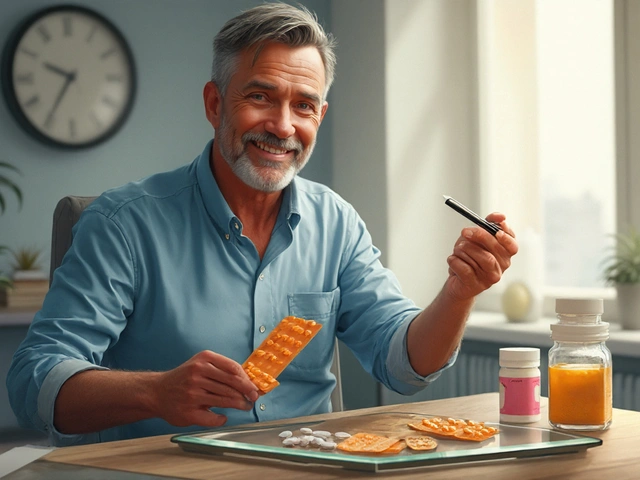Scalp Sunburn Risk Calculator
Risk Assessment
How much sun exposure risk are you facing? Answer these questions to calculate your scalp sunburn risk level.
If you love summer outings but hate the sting of a burnt scalp, you’re not alone. The top of your head often gets the shortest end of the stick when the sun is blazing, especially if you sport short hair or spend hours outdoors. Below are practical steps you can take right now to keep your scalp safe and your hair happy.
What is Scalp Sunburn?
Scalp sunburn is an inflammation of the skin on the top of the head caused by overexposure to ultraviolet (UV) radiation. It can feel like a painful, red patch that may peel or develop blisters, just like a sunburn on any other part of the body. Because the scalp is often hidden under hair, you might not notice the early signs until the damage is already done.
Why is the Scalp So Vulnerable?
- Hair provides only partial shade; UV rays can still reach the skin between strands.
- Many people have less melanin on the scalp than on the face, especially those with lighter hair colors.
- Hair thinning, bald patches, or a shaved head remove natural protection entirely.
Understanding UV Radiation
UV radiation is the portion of sunlight that carries enough energy to damage skin cells. It’s split into UVA (aging) and UVB (burning) wavelengths. UV Index forecasts, available on most weather apps, tell you how strong the sun is at any given hour. When the UV Index hits 6 or higher, protective measures become essential.

Key Prevention Strategies
1. Choose the Right Sunscreen
Not all sunscreens are created equal for scalp use. Look for products that are labeled "broad‑spectrum" and have a Sun Protection Factor (SPF) of at least 30. A lightweight, non‑greasy formula works best under hair because it won’t weigh down strands or leave a visible residue.
| Type | Active Ingredient | Pros | Cons | Best For |
|---|---|---|---|---|
| Mineral (Physical) | Zinc Oxide, Titanium Dioxide | Starts protecting immediately; less skin irritation | Can leave a slight white cast on dark hair | Sensitive scalps, kids, or those who avoid chemicals |
| Chemical | Avobenzone, Octocrylene | Thin texture, no white residue | Needs 15‑minute wait before exposure; may cause irritation | Normal to oily scalp, everyday use |
| Spray | Varies (often chemical) | Easy to apply, good for hard‑to‑reach spots | Risk of inhalation; uneven coverage | Short hair or shaved heads |
| Leave‑In Conditioner with SPF | Mineral or chemical blend | Provides moisture plus UV protection | Lower SPF (usually 15‑20) | Dry or color‑treated hair |
Apply at least a nickel‑sized dollop (about 1ml) directly onto the scalp, and reapply every two hours or after swimming/sweating.
2. Wear Protective Gear
A good hat does more than shade your face. Choose a Wide‑Brim Hat
A wide‑brim hat features a brim of four inches or more that casts a shadow over the entire scalp. Look for styles made from UPF‑rated fabrics. If you prefer a cap, opt for a bucket hat with a 3‑inch brim that still covers the crown. Another option is UPF Clothing UPF (Ultraviolet Protection Factor) clothing is engineered to block a high percentage of UV rays. A lightweight, breathable UPF shirt with a fold‑over collar can protect the back of the neck and the lower scalp while you’re active. The sun’s rays are strongest between 10a.m. and 4p.m. If you can, schedule hikes, sports, or beach trips outside those hours. When you can’t, check the UV Index The UV Index is a scale from 0 to 11+ that predicts how much UV radiation will reach the earth’s surface. A value of 3-5 is moderate; 6-7 is high; 8+ is very high to extreme. On high‑UV days, double up on protection-apply sunscreen, wear a hat, and seek shade whenever possible. Even water‑resistant sunscreens lose effectiveness after about 80 minutes in the water or after a heavy workout. Carry a small travel‑size sunscreen tube in your bag and make reapplication a habit. If you notice severe redness, blistering, or peeling that doesn’t improve after a few days, it’s time for a professional evaluation. Persistent scalp sunburn can increase the risk of skin cancer, especially on bald or thinning areas. A dermatologist can prescribe prescription‑strength creams, recommend laser therapy, or conduct a skin‑cancer screening if needed. Yes, but make sure it’s broad‑spectrum and water‑resistant. Facial sunscreens often have a higher SPF and thinner consistency, which can work well under hair if you apply it carefully. Sprays are convenient for hard‑to‑reach spots, but you must spray close to the scalp and then massage the product in. Check the label for “full‑coverage” claims. Even with a hat, UV rays can reflect onto exposed skin, so reapply every two hours or after swimming or heavy sweating. Mineral (physical) sunscreens with zinc oxide or titanium dioxide are less likely to cause irritation, making them a good choice for sensitive or eczema‑prone scalps. SPF‑infused conditioners or sprays can supplement protection but usually have lower SPF (15‑20). They should be used alongside a dedicated scalp sunscreen for full coverage.3. Mind Your Hair Care Routine
4. Time Your Outdoor Activities
5. Reapply After Water or Sweat
Special Considerations for Different Hair Types
Common Mistakes to Avoid

Quick Scalp‑Sun Protection Checklist
When to See a Dermatologist
Frequently Asked Questions
Can I use regular facial sunscreen on my scalp?
Do spray sunscreens provide enough coverage for the scalp?
How often should I reapply sunscreen when I’m wearing a hat?
Is mineral sunscreen better for sensitive scalps?
Can hair products with SPF replace regular sunscreen?






Virginia Dominguez Gonzales
October 17, 2025 AT 16:28Picture this: a blazing summer day, the sky a relentless furnace, and you stepping out with your trusty hat and a bottle of sunscreen, feeling like a warrior ready to take on the sun.
Every strand of hair becomes a flag of defiance, waving proudly against the ultraviolet onslaught.
But the real battle happens on the scalp, that often‑overlooked battlefield where burn and pain can strike without warning.
First, choose a broad‑spectrum SPF 30+ sunscreen that feels like a feather, not a cement slab, and apply it directly to the skin where the hair can’t hide.
Massage it in with the confidence of a champion, covering the crown, the temples, and even those sneaky side patches.
Second, don a wide‑brim hat that casts a shadow as wide as your optimism, preferably made from UPF‑rated fabric that blocks those sneaky rays.
If you prefer a cap, pick one with a snug fit and a 3‑inch brim to shield the crown without sacrificing style.
Third, reapply every two hours-yes, every two hours-no matter if you’re swimming, sweating, or simply basking in the glow of a beach bonfire.
Carry a travel‑size tube in your bag; it’s your secret weapon, the sidekick that never quits.
Fourth, incorporate a leave‑in conditioner with SPF; think of it as armor for color‑treated hair, keeping those vivid hues from fading under the sun’s relentless gaze.
Fifth, schedule your outdoor adventures outside the 10 am‑4 pm window whenever possible; the sun’s fiercest arrows fly during those hours.
When you can’t avoid peak sun, check the UV Index and double‑down on protection-add a second layer of spray sunscreen, then a hat, then a shade‑seeking pause.
Sixth, protect the ears and neck, those tender allies that often get overlooked but can suffer the same fiery assault.
Lastly, if you ever notice persistent redness, blistering, or peeling that won’t quit, don’t wait-see a dermatologist, because prevention is heroic, but treatment is essential.
Remember, each step you take is a tribute to your scalp’s health, a celebration of sun‑smart living, and a declaration that you won’t let the sun win.
Carissa Padilha
October 19, 2025 AT 01:48The government isn’t just handing out sunscreen; they’re quietly pushing chemicals that make us dependent on their brands.
They want us to trust big‑corp formulas while they monitor every spray, every dab, every UV‑weighted data point.
Ask yourself why the "natural" mineral sunscreens are always more expensive and harder to find in mainstream stores.
It’s a covert strategy to keep us buying synthetic stuff that leaches into our pores and, rumor has it, into the water supply.
Stay vigilant, read the labels, and don’t be fooled by the glossy marketing campaigns.
Richard O'Callaghan
October 20, 2025 AT 11:08hey i just want to say u shouldnt put 2 much sunblock or it will make ur hair look like a greasi pizza slice i know i sound weird but i read it on a forum lol plz dont take it personal.
Darryl Gates
October 21, 2025 AT 20:28Great rundown! I’d add that when you’re applying spray sunscreen, hold the can about six inches from the scalp and give it a light mist, then gently rub it in with your fingertips-this ensures even coverage without the white cast.
Also, remember that even mineral formulas need a short waiting period before you head out; they protect instantly but can feel a bit powdery until they settle.
Winston Bar
October 23, 2025 AT 05:48Another hat, another hassle.
Russell Abelido
October 24, 2025 AT 15:08Reading through all these tips feels like getting a warm hug from a wise old tree 🌳.
It’s amazing how a simple, lightweight SPF spray can turn a dreaded scalp burn into a gentle whisper of protection.
The idea of pairing it with a wide‑brim hat is poetic, like giving your head a cozy, sun‑shielding blanket.
Even the reminder to reapply every two hours feels like a rhythmic drumbeat, urging us to stay in sync with nature’s cycles.
In the end, caring for our scalp is an act of self‑love, a daily ritual that honors the very crown we wear.
Steve Holmes
October 26, 2025 AT 00:28Absolutely spot on, the guide covers everything-from SPF selection, to hat choice, to timing, and even reapplication reminders, which are often overlooked, and I love the emphasis on checking UV Index, because knowledge is power, and the practical tips on spray versus mineral sunscreens really help us tailor our routine to personal preferences, plus the reminder about ears and neck-so often missed-shows thoroughness, and the final note on seeing a dermatologist ties it all together nicely.
Tom Green
October 27, 2025 AT 08:48Everyone, remember that protection isn’t one‑size‑fits‑all; if you have a shaved head, a tight‑fitting UPF cap is your best friend, while those with long curls might prefer a lightweight spray that won’t weigh down the volume.
Mix and match the tools that feel right for you, and you’ll stay safe and stylish all summer.
Emily Rankin
October 28, 2025 AT 18:08While some folks spin conspiracies, the simple truth shines bright: a little sunscreen and a good hat can preserve both health and confidence.
Embrace the sun responsibly, and let your radiant spirit shine without the burn.
Rebecca Mitchell
October 30, 2025 AT 03:28use spray just enough dont overdo it
Roberta Makaravage
October 31, 2025 AT 12:48Morality 101: ignoring scalp sunburn isn’t just careless, it’s reckless 🌞🚫. Everyone has a duty to protect their skin, and neglecting this basic health step contributes to a culture of self‑harm. Choose wisely, act responsibly, and let’s set a standard that respects our bodies. 🙏💡
Lauren Sproule
November 1, 2025 AT 22:08hey all thx for the tips i tried the spray thing its workin real good tho i think i might need more often if i stay in sun alot lol hope you have a nice day